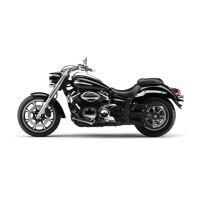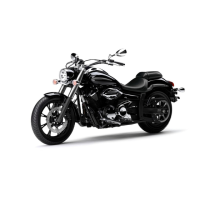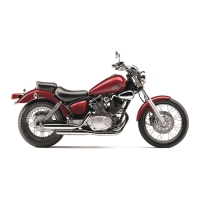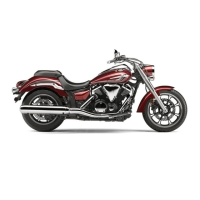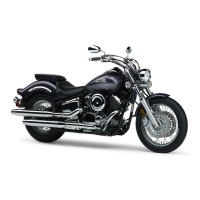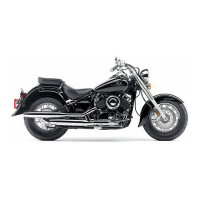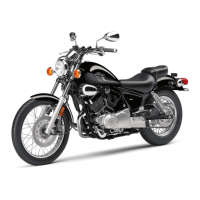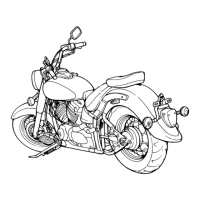Do you have a question about the Yamaha STAR XVS950 and is the answer not in the manual?
Owner's responsibilities, safe riding practices, and pre-operation checks.
Essential protective gear and precautions against carbon monoxide poisoning.
Guidelines for loading, accessories, and their impact on stability and safety.
Identification of key components via left, right views, and controls.
Operation of the immobilizer system and main switch/steering lock.
Explanation of warning lights, indicator lights, and the multi-function meter.
Functions of handlebar switches, clutch lever, and brake levers.
Operation of brake pedals, fuel system, and catalytic converter safety.
Procedures for seat removal and adjusting the rear shock absorber spring preload.
Sidestand function and the ignition circuit cut-off system.
Essential checks before operating the vehicle for safety and performance.
Procedure for verifying the functionality of the sidestand switch.
Steps for starting the engine and proper gear shifting techniques.
Tips for fuel efficiency and guidelines for the engine break-in period.
Safe methods for parking and associated operational precautions.
Overview of maintenance charts, intervals, and the owner's tool kit.
Procedures for checking, changing engine oil, and replacing the air filter.
Tire inspection, air pressure, and wheel bearing checks.
Adjusting brake levers/pedals, checking fluid, and pad wear.
Battery maintenance, charging, fuse replacement, and bulb replacement.
General troubleshooting advice and a chart for common engine issues.
Recommended methods for cleaning and maintaining the motorcycle.
Instructions for short-term and long-term storage to protect the vehicle.
Key technical details including dimensions, engine, fuel, tires, and brakes.
Recording key, vehicle identification numbers, and model label data.
Owner's responsibilities, safe riding practices, and pre-operation checks.
Essential protective gear and precautions against carbon monoxide poisoning.
Guidelines for loading, accessories, and their impact on stability and safety.
Identification of key components via left, right views, and controls.
Operation of the immobilizer system and main switch/steering lock.
Explanation of warning lights, indicator lights, and the multi-function meter.
Functions of handlebar switches, clutch lever, and brake levers.
Operation of brake pedals, fuel system, and catalytic converter safety.
Procedures for seat removal and adjusting the rear shock absorber spring preload.
Sidestand function and the ignition circuit cut-off system.
Essential checks before operating the vehicle for safety and performance.
Procedure for verifying the functionality of the sidestand switch.
Steps for starting the engine and proper gear shifting techniques.
Tips for fuel efficiency and guidelines for the engine break-in period.
Safe methods for parking and associated operational precautions.
Overview of maintenance charts, intervals, and the owner's tool kit.
Procedures for checking, changing engine oil, and replacing the air filter.
Tire inspection, air pressure, and wheel bearing checks.
Adjusting brake levers/pedals, checking fluid, and pad wear.
Battery maintenance, charging, fuse replacement, and bulb replacement.
General troubleshooting advice and a chart for common engine issues.
Recommended methods for cleaning and maintaining the motorcycle.
Instructions for short-term and long-term storage to protect the vehicle.
Key technical details including dimensions, engine, fuel, tires, and brakes.
Recording key, vehicle identification numbers, and model label data.
| Displacement | 942cc |
|---|---|
| Compression Ratio | 9.0:1 |
| Fuel System | Fuel injection |
| Ignition | TCI |
| Transmission | 5-speed |
| Final Drive | Belt |
| Engine Type | Air-cooled, 4-stroke, SOHC, V-twin |
| Bore x Stroke | 85.0 mm x 83.0 mm |
| Front Suspension | Telescopic fork |
| Rear Suspension | Swingarm |
| Front Brakes | Hydraulic disc, 298mm |
| Rear Brakes | Hydraulic disc, 298mm |
| Length | 2, 415 mm |
| Width | 925 mm |
| Height | 1, 100 mm |
| Seat Height | 700 mm |
| Wheelbase | 1, 665 mm |
| Ground Clearance | 140 mm |
